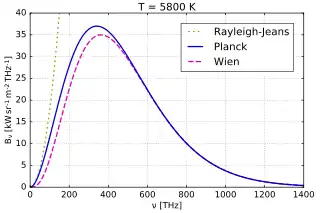Wien approximation
Wien's approximation (also sometimes called Wien's law or the Wien distribution law) is a law of physics used to describe the spectrum of thermal radiation (frequently called the blackbody function). This law was first derived by Wilhelm Wien in 1896.[1][2][3] The equation does accurately describe the short wavelength (high frequency) spectrum of thermal emission from objects, but it fails to accurately fit the experimental data for long wavelengths (low frequency) emission.[3]

Details
Wien derived his law from thermodynamic arguments, several years before Planck introduced the quantization of radiation.
Wien's original paper did not contain the Planck constant.[1] In this paper, Wien took the wavelength of black body radiation and combined it with the Maxwell–Boltzmann distribution for atoms. The exponential curve was created by the use of Euler's number e raised to the power of the temperature multiplied by a constant. Fundamental constants were later introduced by Max Planck.
Details are contained in a 2009 paper by J. Crepeau entitled "A Brief History of the T4 Radiation Law".[4] The law may be written as[5]
or, by introducing natural Planck units:
where:
- is the amount of energy per unit surface area per unit time per unit solid angle per unit frequency emitted at a frequency ν.
- is the temperature of the black body.
- is the ratio of frequency over temperature.
- is the Planck constant.
- is the speed of light.
- is the Boltzmann constant.
This equation may also be written as[3][6]
where is the amount of energy per unit surface area per unit time per unit solid angle per unit wavelength emitted at a wavelength λ.
The peak value of this curve, as determined by taking the derivative and solving for zero, occurs at a wavelength λmax and frequency νmax of:[7]
in cgs units.
Relation to Planck's law
The Wien approximation was originally proposed as a description of the complete spectrum of thermal radiation, although it failed to accurately describe long wavelength (low frequency) emission. However, it was soon superseded by Planck's law, developed by Max Planck. Unlike the Wien approximation, Planck's law accurately describes the complete spectrum of thermal radiation. Planck's law may be given as
The Wien approximation may be derived from Planck's law by assuming . When this is true, then
and so Planck's law approximately equals the Wien approximation at high frequencies.
Other approximations of thermal radiation
The Rayleigh–Jeans law developed by Lord Rayleigh may be used to accurately describe the long wavelength spectrum of thermal radiation but fails to describe the short wavelength spectrum of thermal emission.[3][5]
See also
References
- Wien, W. (1897). "On the division of energy in the emission-spectrum of a black body" (PDF). Philosophical Magazine. Series 5. 43 (262): 214–220. doi:10.1080/14786449708620983.
- Mehra, J.; Rechenberg, H. (1982). The Historical Development of Quantum Theory. Vol. 1. Springer-Verlag. Chapter 1. ISBN 978-0-387-90642-3.
- Bowley, R.; Sánchez, M. (1999). Introductory Statistical Mechanics (2nd ed.). Clarendon Press. ISBN 978-0-19-850576-1.
- Crepeau, J. (2009). "A Brief History of the T4 Radiation Law". ASME 2009 Heat Transfer Summer Conference. 1. ASME. pp. 59–65. doi:10.1115/HT2009-88060. ISBN 978-0-7918-4356-7.
- Rybicki, G. B.; Lightman, A. P. (1979). Radiative Processes in Astrophysics. John Wiley & Sons. ISBN 978-0-471-82759-7.
- Modest, M. F. (2013). Radiative Heat Transfer. Academic Press. pp. 9, 15. ISBN 978-0-12-386944-9.
- Irwin, J. A. (2007). Astrophysics: Decoding the Cosmos. John Wiley & Sons. p. 130. ISBN 978-0-470-01306-9.
- Hal Archives Ouvertes, Wien's Displacement Law in Improved oxidation resistance of high emissivity coatings, hal-02308467